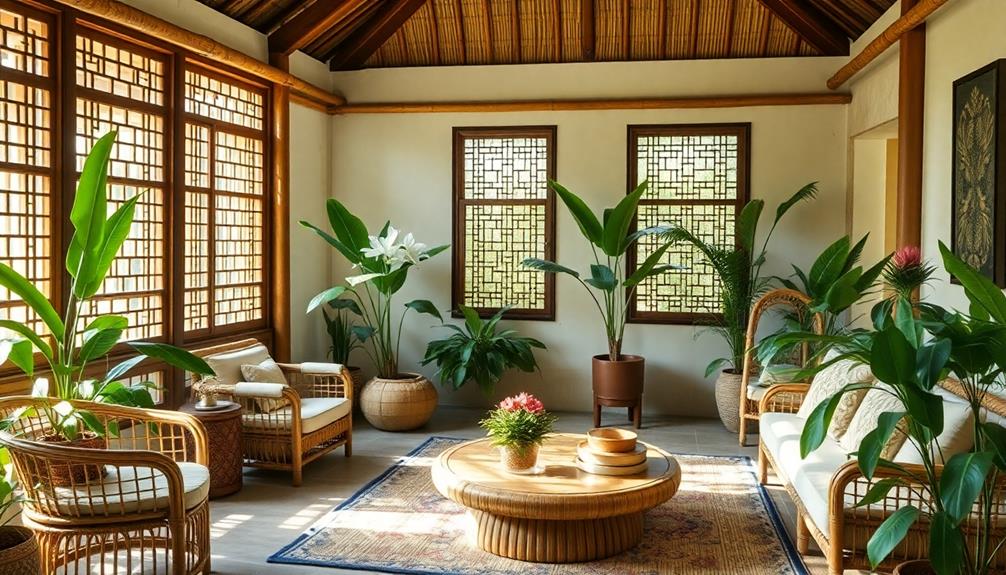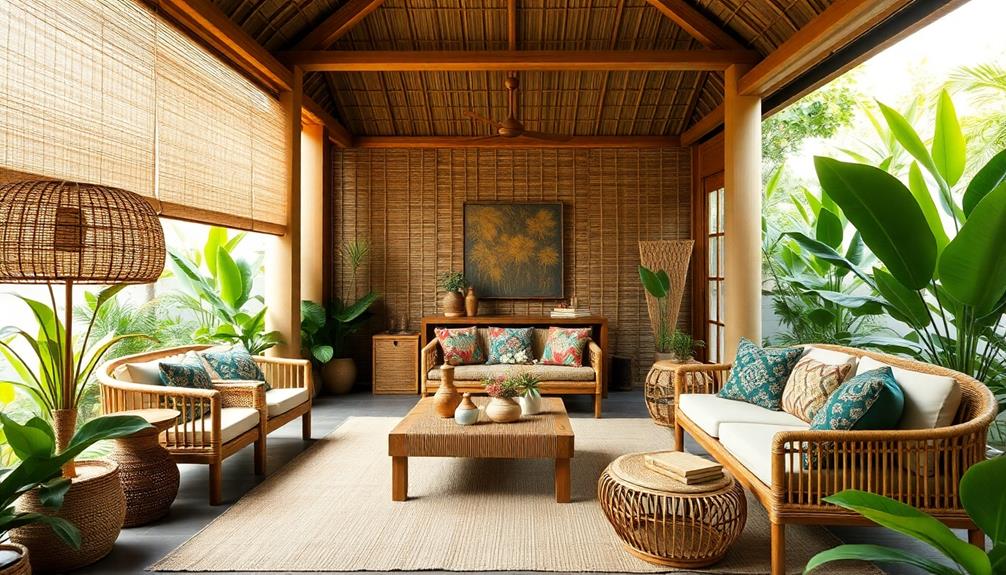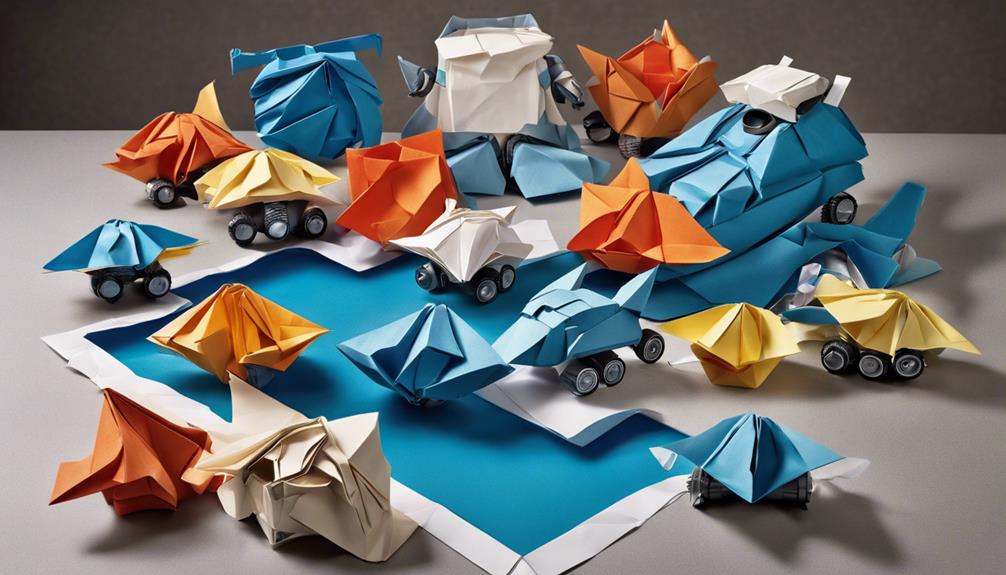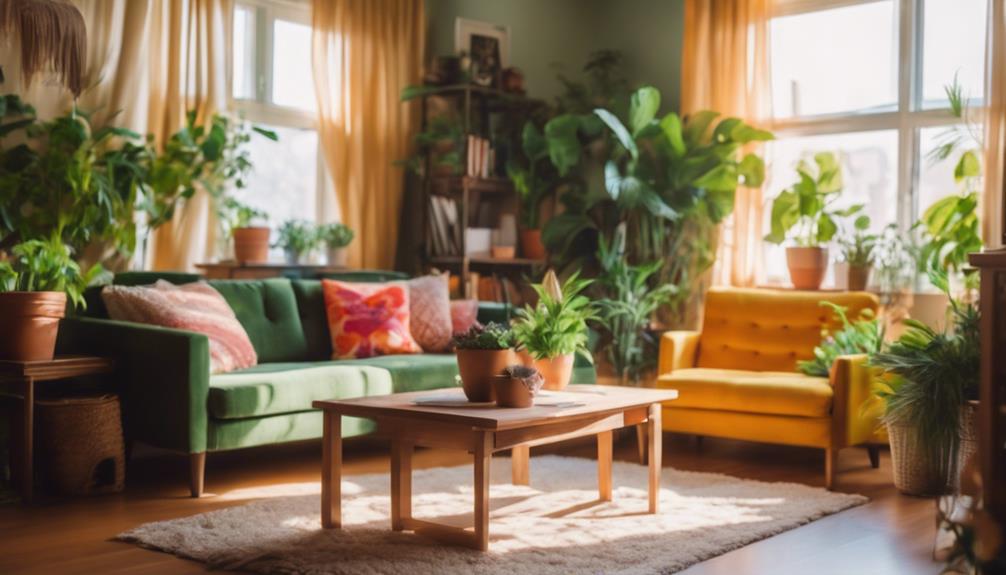Sustainable materials are key in Indonesian interior design, boosting beauty while caring for the planet. You'll find sustainable wood, bamboo, and rattan being prioritized, reflecting both cultural heritage and eco-friendly practices. Many designers now embrace local sourcing and biodegradable options like cassava plastic, which enhances environmental responsibility. Innovations in design also focus on minimizing waste, such as using joinery methods that reduce reliance on metal fasteners. As trends shift towards nature-inspired aesthetics, the commitment to sustainability will only grow stronger. Explore how these practices shape Indonesia's interior landscape and their potential for the future.
Key Takeaways
- Sustainable sourcing of materials like wood and bamboo is essential for reducing environmental impact in Indonesian interior design.
- Utilizing locally sourced materials and traditional craftsmanship enhances cultural significance while promoting eco-friendly practices.
- Innovative approaches, such as biodegradable materials and joinery methods, contribute to waste reduction and sustainable design solutions.
- Trends toward nature-inspired aesthetics and open layouts reflect a growing demand for environmentally responsible and comfortable living spaces.
- Collaboration between local artisans and international designers fosters sustainability and integrates unique Indonesian aesthetics into modern design.
Challenges in Sustainable Wood Sourcing
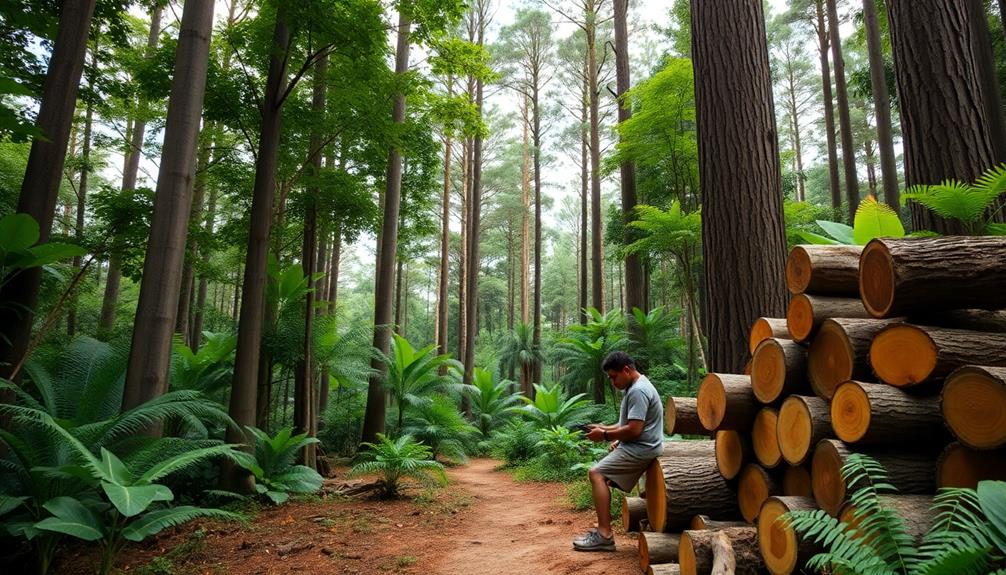
When it comes to sustainable wood sourcing in Indonesia, companies often run into a series of roadblocks. The increasing demand for wood products, which hit an export value of $13.27 billion by November 2022, complicates efforts to source from sustainably managed forests.
You might notice that while there's a growing interest in sustainable architecture, public awareness about the importance of sustainable practices in the wood industry remains low. This gap stifles progress toward eco-friendly sourcing. Additionally, the cultural significance of materials in Indonesian design, such as the use of natural elements in Indonesian Kitchen Decor, emphasizes the need for sourcing that respects both the environment and local traditions.
Moreover, the growth of the wood industry is directly linked to the challenges in ensuring that wood comes from responsibly managed forests. Many companies lack the necessary commitment to environmentally friendly practices, which makes it difficult to promote sustainability in their operations.
As a potential consumer or designer, you'll see that this disconnect between consumer demand for eco-friendly materials and the actual practices in wood sourcing highlights a critical need for improved transparency and accountability.
To truly embrace sustainable architecture, it's essential for companies to bridge this gap, ensuring that their sourcing aligns with the values of environmental responsibility and sustainable development.
Minimizing Wood Waste Strategies
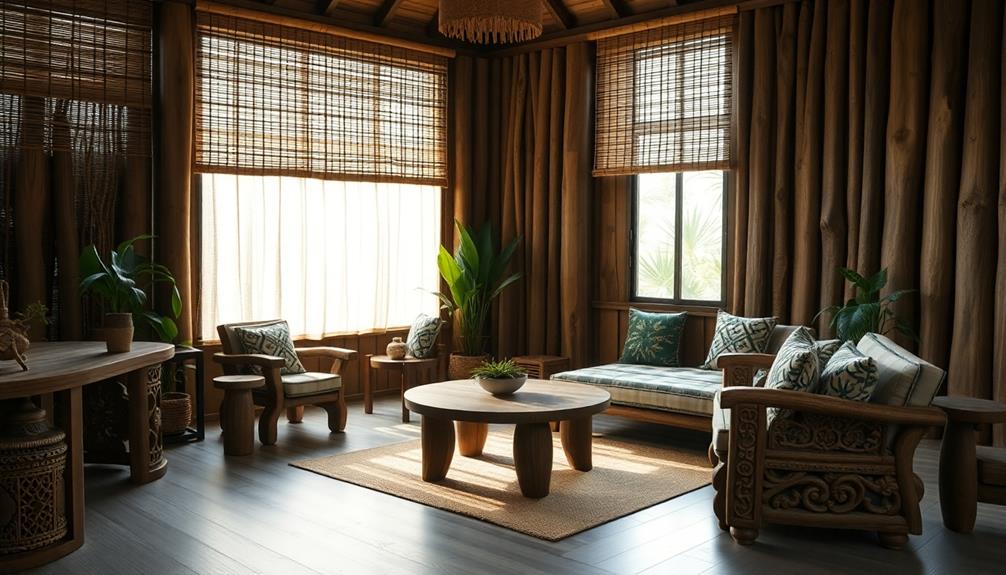
Minimizing wood waste is essential for sustainable interior design, and innovative strategies are making a considerable impact. One standout example is the Jia Pavilion at Jia Curated Kiosks, which promotes material reuse and waste reduction through its clever design for reassembly.
By employing joinery methods that eliminate the need for metal fasteners or adhesives, the pavilion considerably reduces wood waste during assembly. This approach aligns with the principles of Balinese design characteristics, which emphasize sustainability through eco-friendly materials and traditional craftsmanship.
Choosing plywood as the primary material for construction not only cuts down on waste but also emphasizes the importance of selecting natural materials in sustainable design. This approach showcases how thoughtful material selection can lead to low or even zero emissions from wood products, promoting eco-friendly construction methods.
Additionally, the emphasis on reusing wood products for future events allows for a more sustainable cycle in the interior design industry.
When you focus on these strategies, you're contributing to a broader movement of sustainability that prioritizes minimizing waste and maximizing the potential of natural materials. By adopting such practices, you can guarantee that your designs not only look good but also support a healthier planet.
Post-Pandemic Design Trends
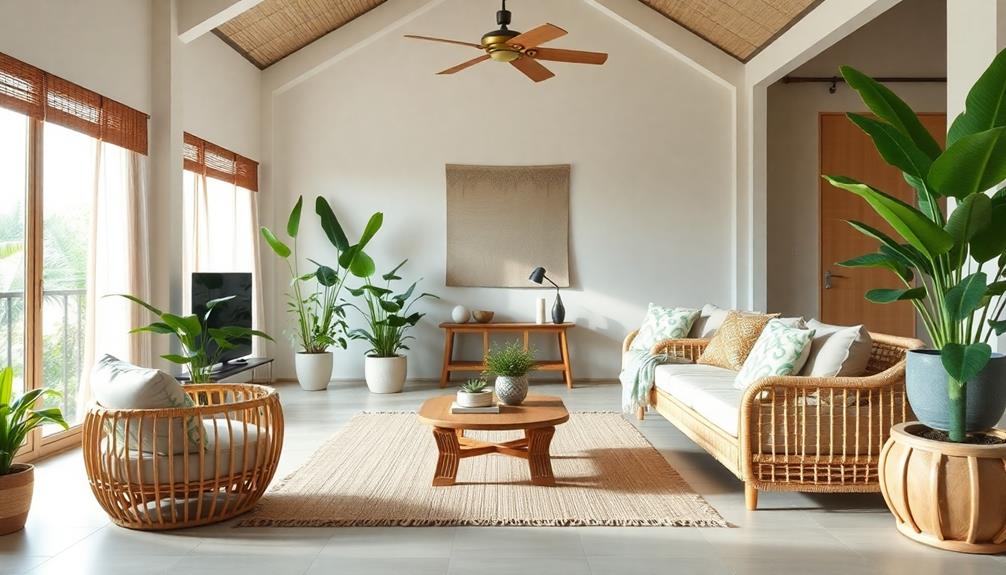
As you explore post-pandemic design trends, you'll notice a strong shift towards nature-inspired aesthetics that bring the outdoors in.
This movement encourages the use of tropical villa plans that focus on open spaces and natural light, making homes feel more inviting.
Homes are embracing open layouts that maximize natural light and air circulation, fostering a deeper connection to nature.
This movement also highlights a growing preference for outdoor living, with villas in Bali featuring expansive terraces that foster a deeper connection to nature.
Nature-Inspired Aesthetics
Embracing nature-inspired aesthetics has become essential in post-pandemic interior design, as many seek to create spaces that foster a sense of tranquility and connection to the outdoors. The Damuh concept embodies this shift, focusing on organic shapes and materials that strengthen your relationship with the environment.
You might notice a growing demand for villas with larger terraces in Bali, highlighting the trend towards outdoor living spaces that enhance natural aesthetics. This trend is also reflected in the rise of eco-friendly designs in modern Indonesian housing, which emphasize sustainable materials and practices that respect the environment and cultural heritage modern Indonesian housing trends.
Open and transparent designs are gaining traction, as they maximize air circulation and natural light, promoting healthier living environments.
By incorporating local natural resources and sustainable practices, you not only support eco-friendliness but also celebrate Indonesia's rich cultural heritage and biodiversity. This approach aligns perfectly with the lifestyle changes many have adopted post-pandemic, where there's a heightened appreciation for climate-responsive designs that prioritize comfort and harmony with nature.
As you explore your own interior spaces, consider how these nature-inspired elements can elevate your home, creating a serene sanctuary that invites the beauty of the outdoors inside.
Emphasis on Outdoor Spaces
The pandemic has reshaped how we think about our living spaces, leading to a noticeable emphasis on outdoor areas in interior design. You might find that larger outdoor spaces, like villas with expansive terraces, are in high demand as people seek to reconnect with nature. This shift highlights a new appreciation for outdoor living, which is seen as essential for well-being.
Open and transparent designs have gained popularity as well, emphasizing natural light and air circulation. These elements create a healthier living environment, aligning with the global trend toward sustainable practices. Embracing nature-inspired design concepts further enhances this connection to the local climate and environment.
Here's a quick overview of the key trends:
| Trend | Description |
|---|---|
| Larger Outdoor Spaces | Expansive terraces and gardens for relaxation. |
| Open & Transparent Designs | Focus on natural light and air circulation. |
| Nature-Inspired Concepts | Designs that reflect the surrounding environment. |
| Sustainable Practices | Eco-friendly materials and construction methods. |
Incorporating these elements into your design not only elevates aesthetics but also promotes a sustainable lifestyle, making your space a true sanctuary.
Importance of Material Selection
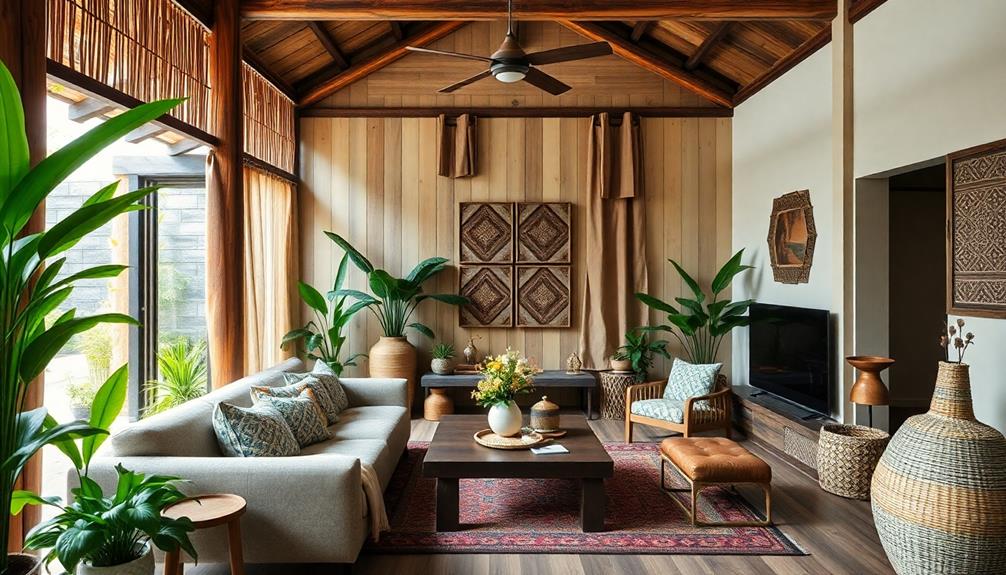
When it comes to Indonesian interior design, your choice of materials plays an essential role in promoting sustainability.
By focusing on sustainable sourcing practices and considering the lifecycle of materials, you can greatly reduce your environmental impact.
Incorporating natural materials like wood and bamboo, which are commonly used in traditional Indonesian style home decor, can enhance the overall aesthetic of your space while remaining eco-friendly.
This intentional selection not only benefits the planet but also enhances the overall aesthetic of your space.
Sustainable Sourcing Practices
Sustainable sourcing practices are essential for creating environmentally responsible interior designs that resonate with both aesthetics and ethics. By prioritizing materials like plywood from sustainably managed forests, you greatly reduce the environmental impact of your selections.
Incorporating elements such as Indonesian decor masks can enhance the cultural narrative of your space while supporting local artisans. Collaborating with companies such as Kayu Lapis Indonesia and DDAP emphasizes the need for responsibly sourced materials, enhancing the sustainability of your design projects.
Incorporating the theme of Material Alchemy allows you to carefully combine various materials, creating eco-friendly solutions that respect local resources and cultural heritage. By utilizing reusable wood products, you not only minimize waste but also set the stage for future setups for events and installations.
This approach showcases the importance of sustainable practices in your work. Focusing on energy-efficient wooden structures further contributes to lowering emissions associated with wood products.
This commitment promotes a more sustainable built environment, ensuring your designs aren't only beautiful but also beneficial for the planet. Embracing these sustainable sourcing practices will help you create interiors that reflect your values while making a positive impact on the environment.
Material Lifecycle Considerations
Choosing the right materials in Indonesian interior design not only shapes the aesthetic appeal of a space but also considerably impacts the environment. When you focus on sustainability, you guarantee that the materials you select contribute positively to the planet. For instance, using sustainably sourced plywood from managed forests helps minimize environmental impact and supports responsible forestry practices.
Additionally, incorporating traditional craftsmanship, such as vibrant artistry in masks, can add unique character to your designs while honoring cultural heritage.
The Material Alchemy theme encourages you to combine local resources and traditional materials, fostering innovative and eco-friendly design solutions. By opting for reusable wood products, you not only facilitate future event setups but also greatly reduce waste, enhancing the material lifecycle. This approach aligns with global sustainability goals, as low or zero emissions from wood products are achievable through careful selection.
Moreover, as public awareness and demand for eco-friendly materials grow, you're empowered to innovate and transform the lifecycle of materials used in your designs. By prioritizing sustainability in your material choices, you contribute to a healthier environment while creating beautiful, functional spaces that resonate with the ethos of responsible design.
Embrace these considerations, and you'll make a lasting impact on both your projects and the world around you.
Biodegradable Material Innovations

In recent years, Indonesia has seen a surge in the exploration of biodegradable materials like cassava plastic, bamboo textiles, and pineapple fibers as eco-friendly alternatives in interior design.
These biodegradable materials not only promote sustainability but also embrace the rich biodiversity of the region, often reflecting the principles found in luxury tropical design aesthetics. You can appreciate how designers blend traditional practices with modern aesthetics, creating products that resonate with cultural significance.
Innovations in biodegradable materials often involve minimal processing techniques, utilizing local resources such as timber and bamboo. However, the current production remains limited to smaller-scale applications, indicating a need for systematic development to expand their use in architecture and design.
You might be intrigued by ongoing research into complex compounds like adhesives and polymers, which could further the versatility of biodegradable materials.
Additionally, techniques like fermentation and distillation are being explored to enhance the range of biodegradable materials. This guarantees that design solutions not only meet functional needs but also align with Indonesian cultural values and environmental harmony.
As you engage with these innovations, consider how they contribute to a sustainable future in interior design.
Cultural Influence on Design
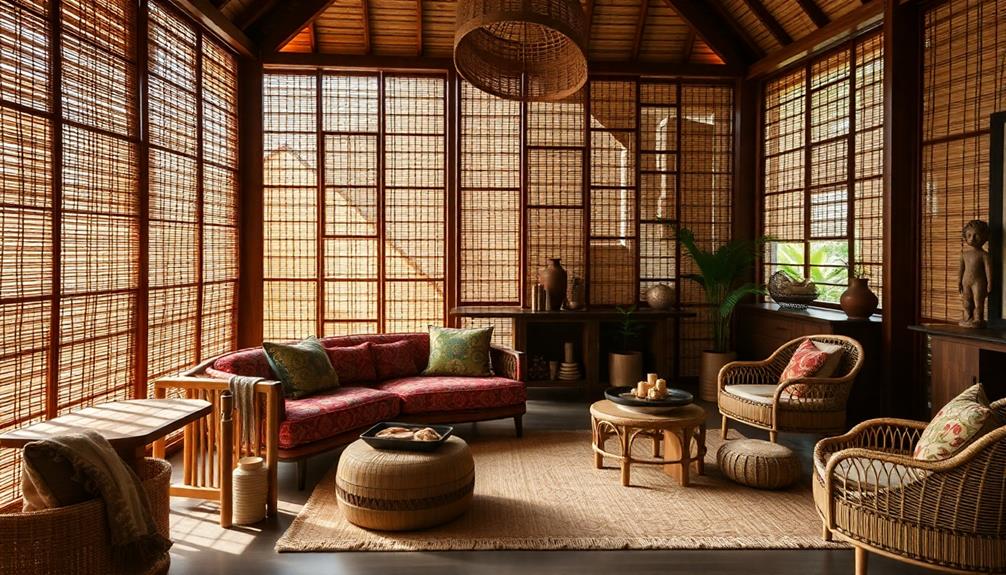
Indonesia's vibrant cultural heritage profoundly shapes its interior design landscape, intertwining various traditions that reflect the country's rich biodiversity. The diverse architectural styles, such as traditional Indonesian houses, markedly influence interior aesthetics, showcasing how local customs and environmental factors meld within design practices.
You'll notice how these influences manifest in sustainable design practices that honor local craftsmanship and materials. Here are three key aspects of cultural influence on Indonesian interior design:
- Diverse Influences: Elements from Indian, Chinese, Arab, and European cultures blend seamlessly, creating a unique aesthetic that celebrates Indonesia's diversity.
- Locally Sourced Materials: The use of bamboo and rattan not only showcases traditional craftsmanship but also aligns with sustainability principles, promoting eco-friendly practices.
- Vernacular Architecture: This architectural style integrates organic and resilient materials, reflecting the region's cultural identity and environmental context.
Future Directions in Sustainability
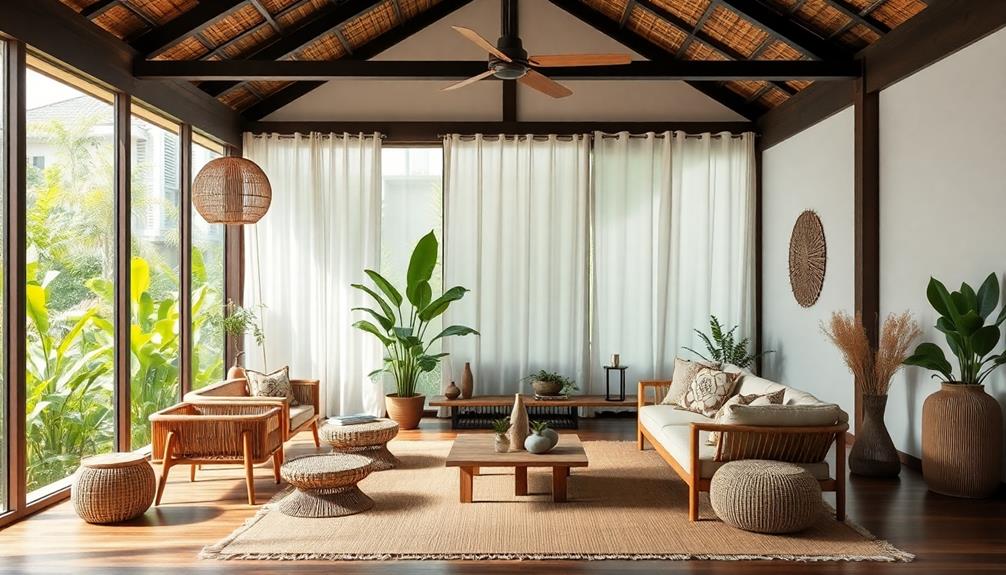
As sustainable interior design continues to evolve, designers are tapping into innovative materials that not only honor local biodiversity but also meet the demand for eco-friendly solutions.
The future of sustainability in Indonesia looks promising as you'll notice a shift towards locally sourced biodegradable materials like bamboo and cassava plastic. These choices not only reduce environmental impact but also celebrate Indonesia's rich cultural heritage, similar to the incorporation of bamboo and natural materials in Indonesian wedding decor.
With the rising public interest in eco-friendly practices, you're likely to see an increase in sustainable interior design solutions that align with global trends toward environmental preservation.
Collaborative efforts between local craftsmen and international designers will foster innovation, enhancing the appeal of Indonesian products in global markets.
Moreover, advancements in technology, such as 3D printing and biomimicry, will play a crucial role in integrating natural aesthetics into contemporary designs.
This integration is set to become a hallmark of Indonesia's sustainable architecture and interior design future.
As you explore this evolving landscape, you'll find that sustainability isn't just a trend; it's a commitment to creating spaces that honor both the environment and cultural identity.
Case Studies in Sustainable Design
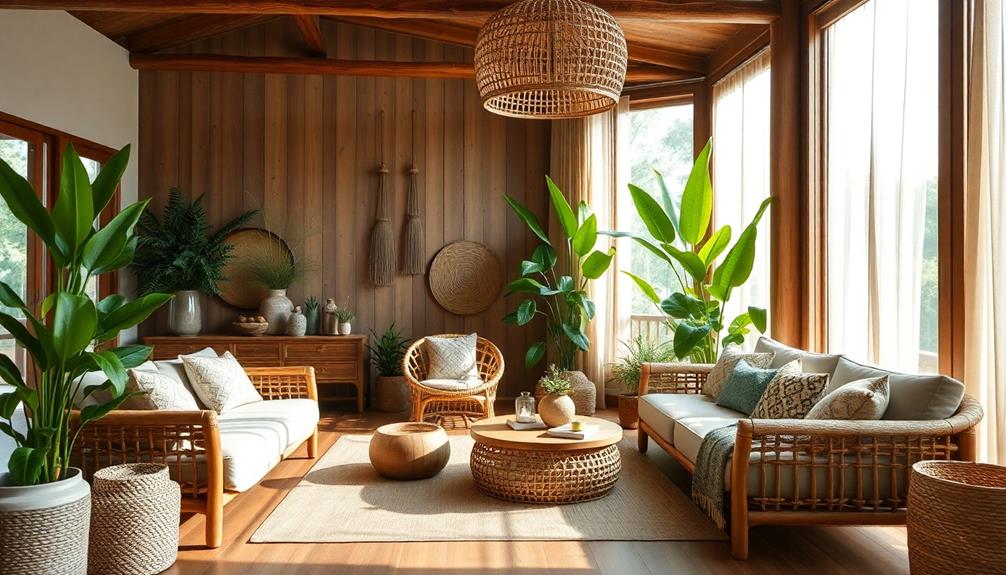
Numerous inspiring case studies showcase the innovative approaches to sustainable design within Indonesia's interior landscape.
These projects not only highlight sustainability but also demonstrate the potential for creative solutions in design. Here are three standout examples:
- Jia Pavilion: This space utilizes joinery methods that eliminate metal fasteners and adhesives, promoting material reuse and minimizing waste. Plywood serves as the primary material, ensuring low or zero emissions during construction.
- Damuh Concept: Reflecting post-pandemic design trends, this concept emphasizes nature-inspired interiors with open layouts that enhance air circulation and natural light. It resonates with the growing desire for environments that foster well-being.
- Biodegradable Innovations: The integration of materials like cassava plastic and bamboo textiles presents exciting opportunities for eco-friendly architecture, aligning with local culture and biodiversity.
These case studies demonstrate how Indonesian designers aren't just keeping up with global sustainability trends; they're leading the charge by creatively using materials and principles that benefit both the environment and the community.
Frequently Asked Questions
What Type of Material Is Best for Sustainable Building Design?
When considering sustainable building design, you'll find that biodegradable materials like bamboo and rattan, alongside responsibly sourced plywood, are excellent choices. They minimize environmental impact while promoting efficiency and supporting local economies.
What Are the Sustainability Plans of Indonesia?
By November 2022, Indonesia's wood product exports hit $13.27 billion, showcasing its commitment to sustainability. You'll see initiatives focusing on responsible forestry, waste reduction, and biodegradable materials to promote environmental responsibility in various sectors.
What Fabrics Are Sustainable Interior Design?
When you explore sustainable interior design, consider fabrics like organic cotton, linen, hemp, and bamboo. Look for recycled materials and innovative textiles like Tencel or pineapple fibers, ensuring they meet eco-friendly certifications for responsible choices.
What Is Sustainable Design in Interior Design?
Imagine a garden where every element thrives harmoniously. Sustainable design in interior design nurtures spaces by using eco-friendly materials, prioritizing health and aesthetics, ensuring your environment reflects nature's beauty while safeguarding our planet's future.
Conclusion
Incorporating sustainable materials into Indonesian interior design isn't just a trend; it's a transformative journey. By prioritizing prudent practices in sourcing, minimizing waste, and embracing biodegradable innovations, you can create spaces that resonate with respect for culture and the environment. As you navigate post-pandemic preferences, remember that selecting the right materials can lead to stunning spaces that showcase sustainability. Together, let's foster a future where design delights while diligently protecting our planet.
